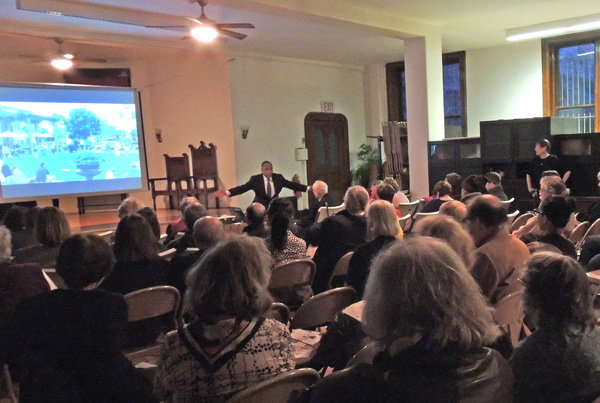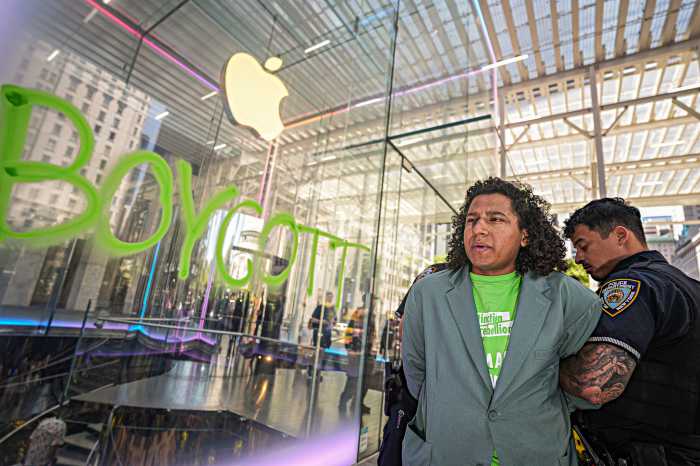
At the Chelsea Waterside Park Association’s annual meeting, NYC Commissioner of Parks & Recreation Mitchell J. Silver FAIP talks about the future of park design.
BY DONATHAN SALKALN | Held on April 8 within the dramatic setting of the German Evangelical Lutheran Church of St. Paul on W. 22nd St., the packed house gathered for Chelsea Waterside Park Association’s annual meeting was honored by a presentation from New York City’s Commissioner of Parks & Recreation.
Close to marking his first year on the job, an animated and impassioned Mitchell J. Silver FAIP led park enthusiasts on a cerebral and visual hike that spanned 29,000 acres of city land and 1,900 city parks. Along the journey, he unveiled a glimpse into the future of NYC park design — as he put it, “for today’s generation, not Robert Moses’ generation.”
Before becoming Commissioner, Silver spent 30 years redesigning cities, lecturing at universities and winning awards in urban design. Now he’s determined to set a new path in park thinking — one that is flexible in creating fun, relaxing and safe experiences for all generations and cultures in surrounding community. During his tour, the Commissioner used potent words not normally associated with park talk. Below are a few with brief descriptions:
CARE & LOVE: “Care comes from a different part of the soul. Throughout the organization we don’t just want to maintain, but also care. Maintaining is doing a checklist. But all of you here care for your park. You put love in that park.” Silver said, addressing the CWPA and 1,800 other city community park associations.
DENSITY: At one point Silver stated, “Density and open space go together.” Later, during the Q&A period, he was asked about the proposal for a micro-park on 20th St. (btw. Sixth & Seventh Aves., on a former Department of Sanitation site). East Chelsea, built as a manufacturing area, has become a residential community within concrete canyons, devoid of any open space. “We are very aware of Councilmember Corey Johnson’s 20th Street Park proposal,” said Silver, not adding much, as the project’s design seed money is at item up for public vote as part of Johnson’s Participatory Budgeting process.
DIANGOSTICS: There’s a saying that 76 percent of all New Yorkers live within a ten-minute walk of a park. Silver begs to differ, asserting that it should “not only be about proximity. It should also about quality, because I can walk to one of those parks and I will not let my child or your child play in that space. It shouldn’t count in that number.”
EQUITY: Mayor Bill de Blasio’s vision of bringing relief to long neglected parks is coming along ahead of schedule. This past year he leveraged $130 million that will rebuild 35 parks and also update an additional 55 parks, none of which have seen any significant investment in two decades. Silver laments, “That was a generation of families that did not have a quality space to play in!”
RESILIENCY: Superstorm Sandy brought $725 million in damages to 392 park sites. It also a demanded a new blueprint for parks in flood zones. The Parks Department is now partnering with the DEC and other agencies in planning for more resilient parks. “Plastic,” noted Silver, “is much more resilient than wood for boardwalks.”
TECHNOLOGY: Close to 65 percent of New York City residents are 47 or younger. Silver recognizes the need to engage everyone that use the parks and is introducing communication platforms to social media channels. He pointed out, “The older generation come to public meetings. The younger generation don’t do public meetings!”
TRANSPARENCY: Up-to-date progress reports for over 400 park projects can be found at nycgovparks.org/planning-and-building/capital-project-tracker. The city’s park planning initiatives can be found at nycgovparks.org/planning-and-building/planning.
At the meeting’s end, I had the opportunity to ask Silver what it was like switching jobs from redesigning cities to now redesigning parks. He laughed, then told me “In city planning everyone says, ‘No, no, no!’ In park planning everyone says, ‘Yes, yes, yes, and how fast can you get it done?’ ”





































